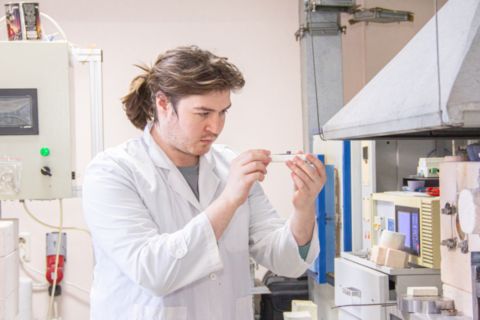Fundamental research is being conducted at the Crystal Growth Laboratory of the SUSU Institute of Engineering and Technology to create a new material that can replace traditional semiconductors. Scientists have taken the long-known barium hexaferrite as a basis and are trying to replace iron with indium in its composition.
"The structure of barium hexaferrite has two sublattices: they are magnetic and slightly cancel each other out. We are trying to "insert" our element into one of the opposing lattices and obtain a more powerful magnetic effect," says Aleksandr Punda, postgraduate student at the Department of Materials Science and Physical Chemistry of Materials. "There are many works in the world on replacing iron with aluminium or gallium. We reviewed the literature, analysed the electronic structure of the nearest elements (according to their place in the Dmitry Mendeleev’s table), and we became interested: what if we try indium – will we be able to replace it? And it worked fine!"
Now science is looking for new knowledge about materials. Over the past year or two, the world was experiencing a problem with semiconductors: resources are running out, traditionally used raw materials are becoming scarce, and they are becoming more expensive. So why not prepare beforehand for the day when nothing is left?
Chelyabinsk researchers are in command of a scanning electron microscope equipped with an X-ray energy dispersive spectrometer, a powder X-ray diffractometer, and a self-assembled tubular furnace with silicon carbide heaters capable of maintaining temperatures up to 1400°C. All these are necessary for the synthesis and quality testing of the material. Scientists must obtain a sample that is homogeneous in chemical composition in order to more accurately characterize its properties.
There is a chemical formula for how to mix oxide powders. The traditional "recipe" requires 12 parts of iron. At the first stage of the experiment, scientists took 11 parts of iron and 1 part of indium. Temperature, exposure time, heating and cooling programs were experimentally optimized. After positive results, work continued. Today, SUSU scientists are the only ones in the world who were able to replace three of the 12 parts of iron with indium. Belarusian colleagues once reached one and stopped their experiments.
If the work of Chelyabinsk scientists to obtain a new substance is successful, it will be possible to begin applied research in a year. The synthesis of semiconductor ceramics is a very broad and fertile topic. The main interest here is for manufacturers of various electronic devices: electrical and radio communications, resistors, thermistors, and sensors.
"The practical applications of the new material are limitless," comments Aleksandr Punda. "We will be able to create more accurate temperature sensors, for example. We can make semiconductors with specified properties for a specific order. We will not compete with nature, physics and chemistry, but we will know: yes, we can do it. And then think about where to use it all."
According to scientists, fundamental research is currently underway, but if necessary, it is possible to move on to practical testing of the new material within two years.
All research is carried out with the support of the Priority 2030 program for the strategic development of universities under the Science and Universities national project.




